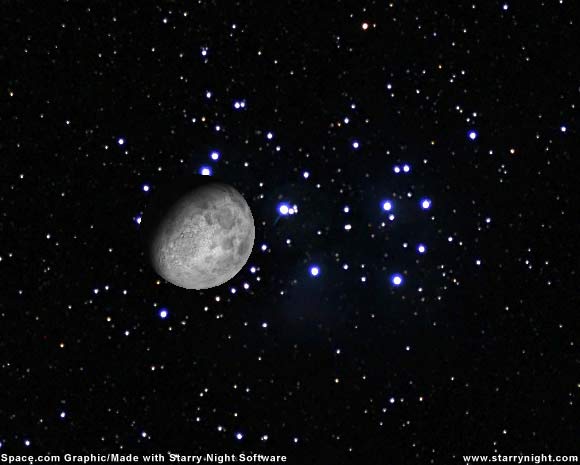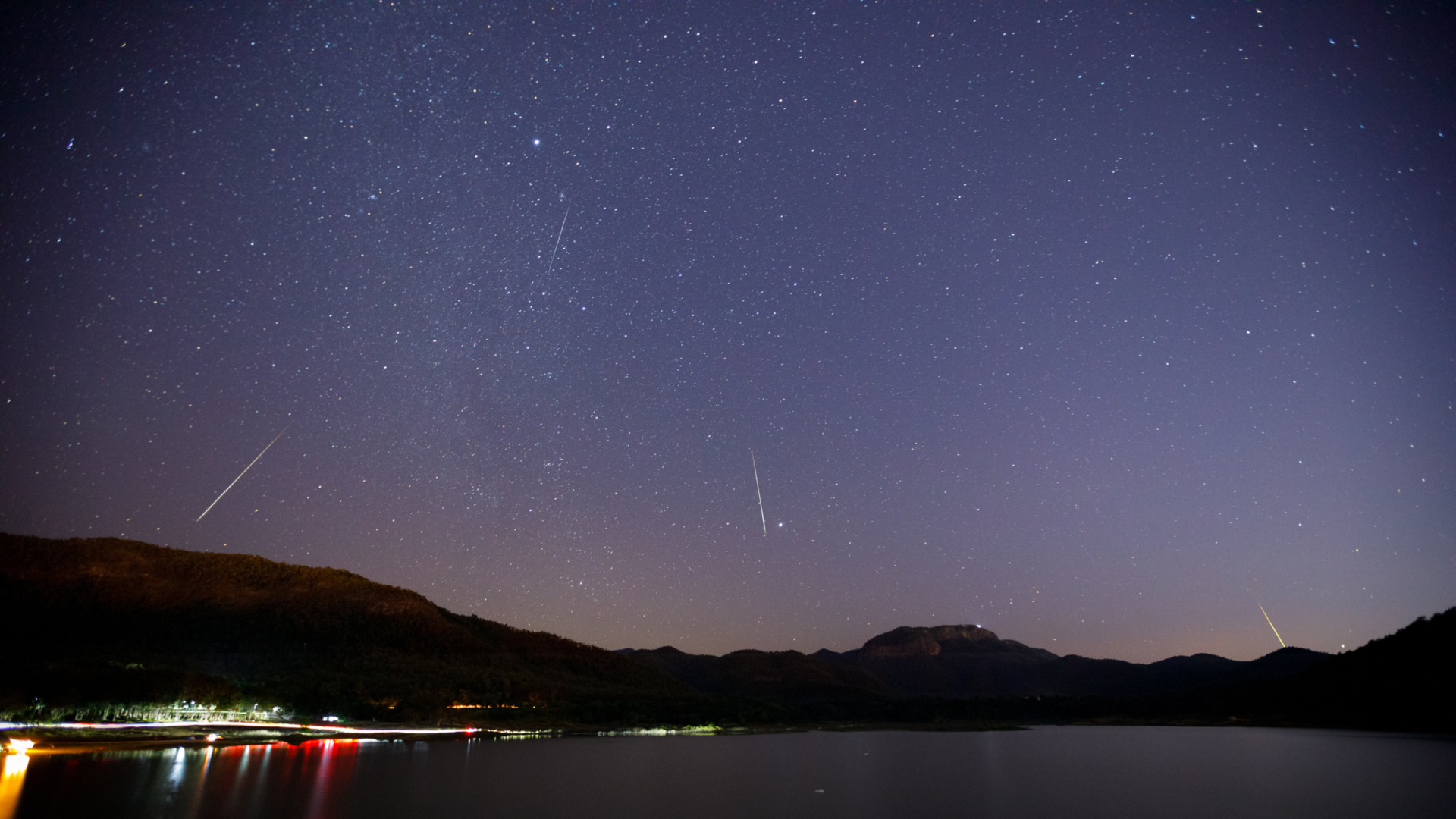Moon to Hide Beautiful Star Cluster

During the next several years, skywatchers around the globe will periodically get a chance to watch the Moon pass in front of the most beautiful of all star clusters, the Pleiades. It will happen thirteen times in 2006 alone, beginning in January.
The easy-to-view events provide an excellent excuse to pull an old telescope out of the closet or buy a new one.
Astronomers refer to this phenomenon as an "occultation," taken from the Latin word occult?re, which means, "to conceal." In most cases, the Moon will hide a bright star or planet, but by passing in front of a cluster of stars like the Pleiades, many stars will be occulted within a span of a few hours.
Few star figures are as familiar as the Pleiades, known also as the Seven Sisters. Anyone having difficulty in recognizing various stars and constellations should start with this star pattern. This group looks at first glance to the naked eye like a shimmering little cloud of light.
But further examination will reveal a tight knot of 6 or 7 stars, though 11 or more have been recorded under excellent conditions. In long-exposure photographs, several stars in the cluster seem to be enveloped in clouds of dust, perhaps left over from the stuff of which they were formed. About 410 light-years away and some 20 light years across, the group may be no older than 20 million years. About 250 stars have been identified as members of this cluster.
The brightest stars glitter like an array of icy blue diamonds on black velvet. Or, as Tennyson wrote, they "glitter like a swarm of fireflies tangled in a silver braid."
The last occultations of the Pleiades took place between 1986 and 1992. Since this cluster lies 4º north of the ecliptic, it can be occulted only when the ascending node of the Moon's orbit is in the Pisces-to-Sagittarius part of the ecliptic. This situation repeats every 18.6 years, the time required for the ascending node to complete one circuit of the ecliptic. Hence, a new "season" of Pleiades occultations has begun that will continue until the year 2010.
Breaking space news, the latest updates on rocket launches, skywatching events and more!
Since the Pleiades are roughly twice as large as the Moon in apparent angular diameter only a part of the cluster can be hidden at any given moment; the Moon can never hide the entire cluster. The seven brightest Pleiads are (on average) around fourth magnitude. They are, in order of brightness: 1) Alcyone, magnitude +2.9; 2) Atlas, +3.6; 3) Electra, +3.6; 4) Maia, +3.8; 5) Merope, +4.2; 6) Taygeta, +4.3; 7) Pleione, +5.1.
It should also be noted, that in most cases, using binoculars or a telescope you'll likely be able to watch perhaps up to several dozen occultations of the fainter stars in this cluster within a few hours.
In the table, below, is the complete list of Pleiades occultations through 2006, which will chiefly favor locations over the Northern Hemisphere. Note that each occultation will be visible only for a specific region of the Earth. In other areas, either the Moon will appear to miss the cluster or the event occurs during the daytime or when the Moon and Pleiades are below your local horizon. Even if your area is not in a favored position to see an occultation, you'll still see the Moon and the Pleiades rather close to each other on the date in question. The date and universal time (U.T.) are given for the midpoint of each event. To convert to your time zone, keep in mind that U.T. that you will need to subtract five hours for Eastern Time, six hours for Central Time, seven hours for Mountain Time and eight hours for Pacific Time. When daylight saving time is in effect, subtract four hours for Eastern Time, five hours for Central Time, etc.
Also important: In some cases, after converting to your time zone, make sure you check to see if the occultation occurs on the previous calendar day. For example: 2006 April 2 at 01h U.T. converts to 2006 April 1 at 20h (9:00 p.m.) Eastern daylight time!
The percentage of the Moon's disk that is illuminated is also provided. Remember that in the case of a waxing Moon, stars will disappear along the Moon's dark limb and reappear along the Moon's bright limb; with a waning Moon the stars will vanish first along the bright limb and pop back into view along the dark limb.
The very best Pleiades occultations will be those involving a crescent Moon, where the Moon's light is not overly bright. In addition, Earthshine may also be evident as a faint grayish-blue illumination of the dark part of the Moon's disk. This dim light is produced by sunlight striking the "dark" side of the Moon after first being reflected from the Earth's surface, clouds and atmosphere. This effect will give the Moon an almost 3-D quality and will only serve to enhance the overall view. The April and July occultations which favor eastern North America, should be especially striking and Night Sky will provide detailed outlooks as we draw nearer to both of these events.
Occultations of the Pleiades for the upcoming year:
| Date/ Universal Time | Illumination/ Phase of Moon | Region of Visibility |
2005 December 13, 20h | 96% Waxing Gibbous | Africa, Europe, W. Asia |
2006 January 10, 02h | 83% Waxing Gibbous | North America, Northern South America |
2006 February 6, 08h | 61% Waxing Gibbous | Japan, Hawaii, Western North America |
2006 March 5, 15h | 37% Waxing Crescent | Eastern Europe, Asia |
2006 April 2, 01h | 17% Waxing Crescent | Eastern North America |
2006 June 23, 01h | 7% Waning Crescent | Northeast Africa, Middle East |
2006 July 20, 07h | 24% Waning Crescent | Eastern North America |
2006 August 16, 13h | 44% Waning Crescent | Japan, Alaska |
2006 September 12, 20h | 67% Waning Gibbous | Eastern Europe, Western Asia |
2006 October 10, 05h | 87% Waning Gibbous | North America |
2006 November 6, 16h | 98% Waning Gibbous | Eastern Europe, Asia |
2006 December 4, 3h | 99% Waxing Gibbous | North America, Western Europe |
2006 December 31, 11h | 88% Waxing Gibbous | Eastern Asia, Northwest North America |
Joe Rao serves as an instructor and guest lecturer at New York's Hayden Planetarium. He writes about astronomy for The New York Times and other publications, and he is also an on-camera meteorologist for News 12 Westchester, New York.
| DEFINITIONS |
1 AU, or astronomical unit, is the distance from the Sun to Earth, or about 93 million miles. Magnitude is the standard by which astronomers measure the apparent brightness of objects that appear in the sky. The lower the number, the brighter the object. The brightest stars in the sky are categorized as zero or first magnitude. Negative magnitudes are reserved for the most brilliant objects: the brightest star is Sirius (-1.4); the full Moon is -12.7; the Sun is -26.7. The faintest stars visible under dark skies are around +6. Degrees measure apparent sizes of objects or distances in the sky, as seen from our vantage point. The Moon is one-half degree in width. The width of your fist held at arm's length is about 10 degrees. The distance from the horizon to the overhead point (called the zenith) is equal to 90 degrees. Declination is the angular distance measured in degrees, of a celestial body north or south of the celestial equator. If, for an example, a certain star is said to have a declination of +20 degrees, it is located 20 degrees north of the celestial equator. Declination is to a celestial globe as latitude is to a terrestrial globe. Arc seconds are sometimes used to define the measurement of a sky object's angular diameter. One degree is equal to 60 arc minutes. One arc minute is equal to 60 arc seconds. The Moon appears (on average), one half-degree across, or 30 arc minutes, or 1800 arc seconds. If the disk of Mars is 20 arc seconds across, we can also say that it is 1/90 the apparent width of the Moon (since 1800 divided by 20 equals 90). |

Joe Rao is Space.com's skywatching columnist, as well as a veteran meteorologist and eclipse chaser who also serves as an instructor and guest lecturer at New York's Hayden Planetarium. He writes about astronomy for Natural History magazine, Sky & Telescope and other publications. Joe is an 8-time Emmy-nominated meteorologist who served the Putnam Valley region of New York for over 21 years. You can find him on Twitter and YouTube tracking lunar and solar eclipses, meteor showers and more. To find out Joe's latest project, visit him on Twitter.
